The word feminism pops up a lot: we’ve heard about it on ‘Broad City’ and ‘Master of None’, read about it in Chimamanda Ngozi Adichie’s ‘We Should All Be Feminists’ and obviously listened to Beyoncé’s ‘Lemonade’.
For better or worse, pop culture cashes in on feminism; regardless of that, the movement has gained important political traction. Despite Hilary Clinton’s surprising presidential defeat, feminists flooded Washington D.C. during inauguration weekend. Against a markedly historical backdrop, half a million women and men marched in the name of feminism and left their imprint upon the movement. These marchers were not alone, as centuries of women—Nasty Women, by modern standards—undergird the feminist tradition. Simone de Beauvoir was proudly—albeit metaphorically—marching on the National Mall, holding the nastiest sign, and screaming “We are not the Second Sex!
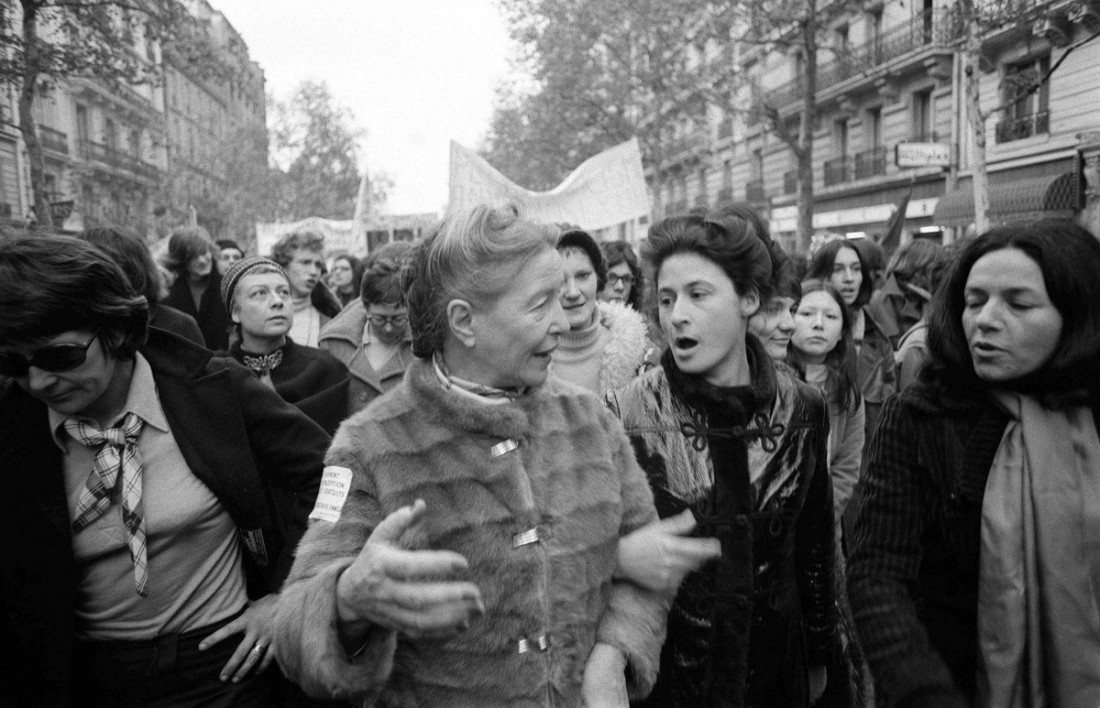
Simone de Beauvoir and Sylvie Le Bon de Beauvoir during a demonstration organized by the Mouvement de Libération des Femmes (MLF) in favor of free and costless abortion and contraception. Paris, 1971.
Who is Simone de Beauvoir?
Quite simply, de Beauvoir was a French writer and philosopher. She was born in 1908 and turned away from a conservative upbringing to pursue an intellectual life, meeting Jean Paul Sartre in the process. The pair pioneered existentialism, theorizing about human experience and freedom. Together, they remained life partners and had an open relationship yet never married. Their philosophies, as well as their tumultuous love story, still garner much attention. This unconventional relationship hints at our heroine’s own sociopolitical leanings.
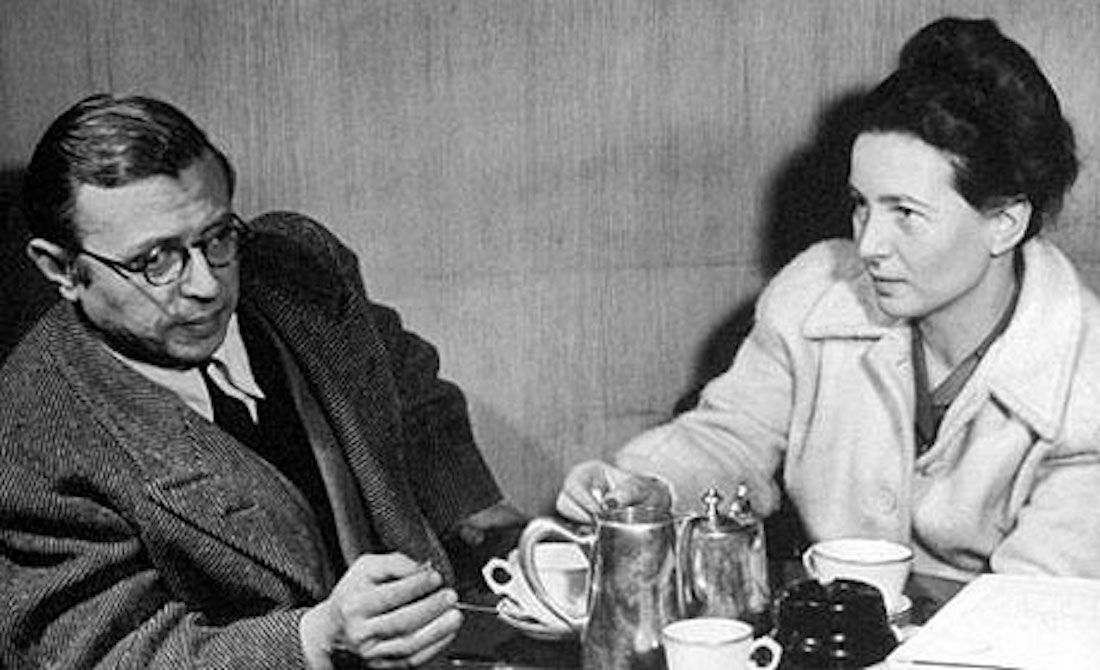
Some (and by some, I mean most) say that de Beauvoir kick-started second-wave feminism with The Second Sex. In 1949, this book laid the groundwork for contemporary feminism, as it seeks to understand and thereby eliminate female inequality. Throughout her book, De Beauvoir uses science and philosophy to dismantle essentialism and ultimately finds nothing about femininity as natural. In fact, she concedes that femininity is a man-made myth that preserves patriarchal society. Ultimately, de Beauvoir urges that both sexes abandon this oppressive system and instead engage in reciprocity. Inciting a feminist revolution, de Beauvoir calls both sexes to “embrace the same essential need for one another” and establish an environment free from gender conflict. (Amen!)
“All oppression creates a state of war. And this is no exception.”
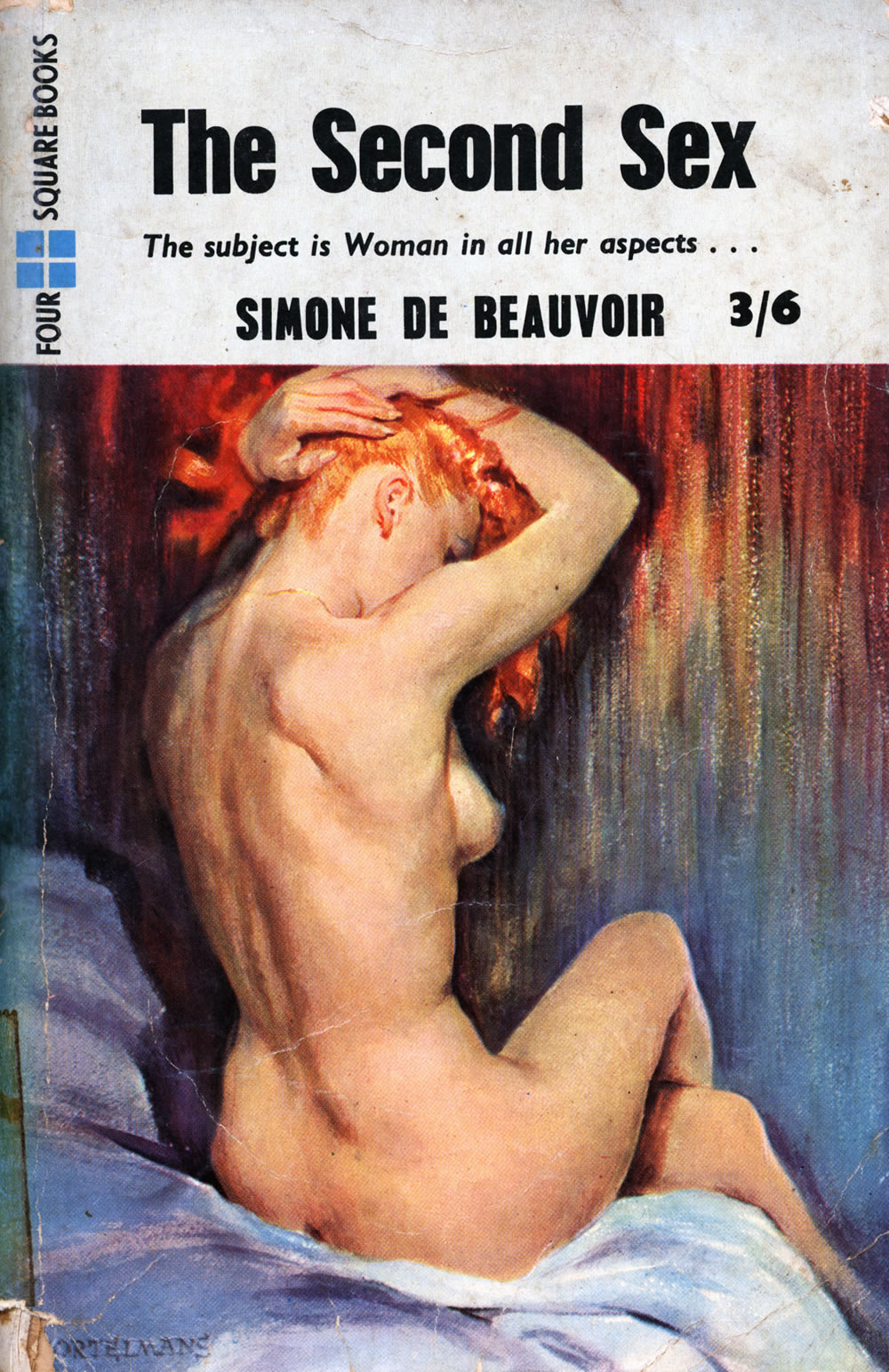
Simple enough, right?
Not really. Our girl was neither lazy nor happy: she approaches human history with a fine-tooth comb, looking everywhere for rationale behind women’s oppression. At nearly one thousand pages, The Second Sex meticulously presents her argument in two volumes and multiple chapters therein contained. She makes her philosophical training obvious, tackling theories from the likes of Hegel, Freud, Engels, and Pythagoras. As if for fun, she sprinkles literary references throughout the text and quotes writers like Poe, Goethe, Shakespeare, and Woolf. She conversationally mentions movie stars, religion, and even menstruation. Such extensive research and references bolster a series of interrelated themes, motifs, and symbols: immanence vs. transcendence, nature vs. nurture, production vs. reproduction, the eternal feminine, the Other, and the praying mantis.
Confused yet? This is complex stuff. But, de Beauvoir is no mere showoff: she is important, and we must appreciate her feminist contributions. I’ve explained some of her key ideas below.
First things first: Who’s the Other?
Setting up her argument, de Beauvoir locates gender inequality at the heart of patriarchal society. Drawing upon Hegel—who claimed that interactions between opposing forces structures reality—de Beauvoir explains that self-understanding is similar. She argues that the patriarchy interprets reality in masculine terms: sex binaries define men and women as opposites, Others. “[A]t the moment when man asserts himself as subject and free being, the idea of the Other arises,” de Beauvoir explains. The Other—a mysterious and threatening role—paradoxically affirms the subject’s existence: basically, the subject is what its other isn’t. Men exaggerate and reinforce gender difference—totally manipulating female subjectivity—as a means to easily categorize reality. De Beauvoir explains:
“Representation of the world, like the world itself, is the work of men; they describe it from their own point of view, which they confuse with absolute truth.”
“Man is defined as a human being and woman as a female – whenever she behaves as a human being she is said to imitate the male.”
The Eternal Feminine = Myth
This is one of de Beauvoir’s biggest ideas. She claims that patriarchies enforce female stagnation by creating myths that advocate idealized, inauthentic, and immutable femininity. While the myths takes many forms, femininity always functions as an unrealizable ideal that governs female behavior; men conflate maternity, child rearing, female sexuality and individuality into this one-size-fits-all category. “The eternal feminine” undergirds essentialism—maintaining that men and women are inherently different—and, therefore, prevents women from questioning their inferiority. De Beauvoir explains:
“To be feminine is to show oneself as weak, futile, passive, and docile. The girl is supposed not only to primp and dress herself up but also to repress her spontaneity and substitute for it the grace and charm she has been taught by her elder sisters. Any self-assertion will take away from her femininity and her seductiveness.”
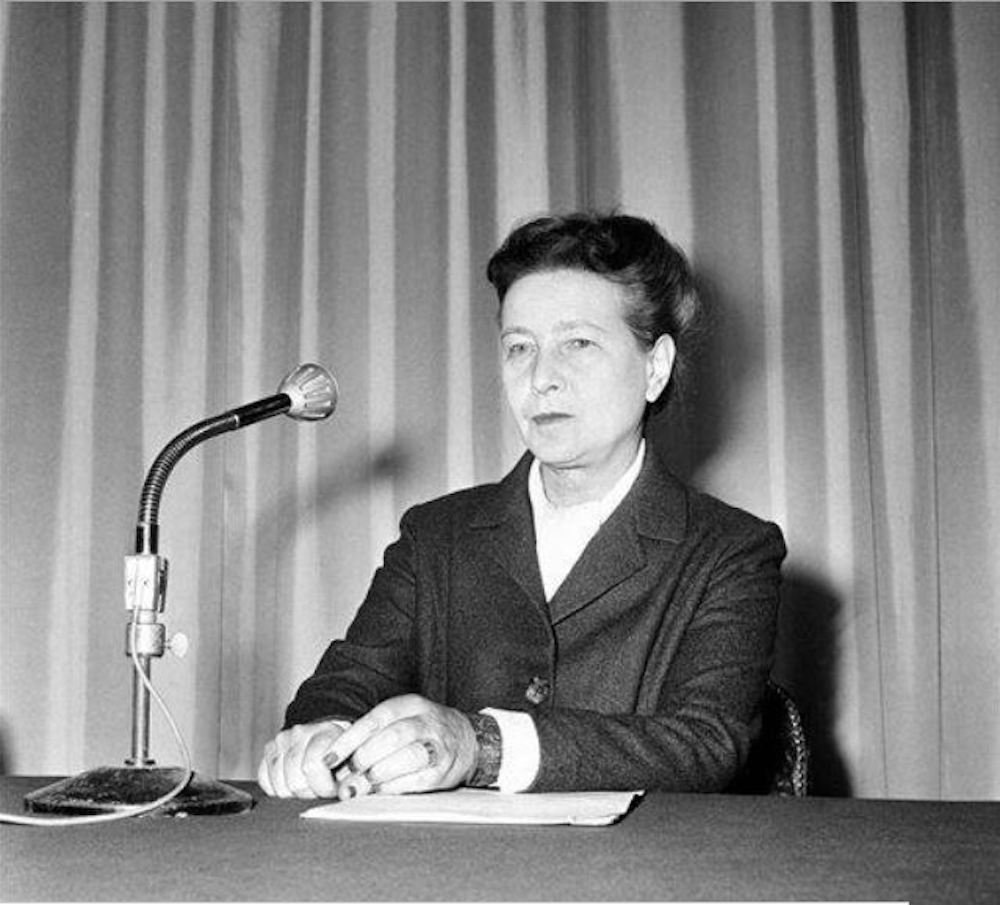
Simone de Beauvoir, Paris, 1964.
Why not act like my elder sisters and neighbor? Don’t all women clean, cook, and curl their hair? De Beauvoir, of course, offers a rebuttal:
“If her functioning as a female is not enough to define woman, if we decline also to explain her through ‘the eternal feminine,’ and if nevertheless we admit, provisionally, that women do exist, then we must face the question: what is a woman?”
[T]he whole of feminine history has been man-made. Just as in America there is no Negro problem, but rather a white problem; just as anti-Semitism is not a Jewish problem, it is our problem; so the woman problem has always been a man problem.
For the sake of all women, de Beauvoir debunks “the eternal feminine” and affirms that experience—not essence—defines the self. She reminds the patriarchy that women are unique and powerful subjects, not Others who share a single story. Rather than serve as the second sex, de Beauvoir ditches clichéd categories and encourages women to participate in her revolution by acting as men’s equal.
So, “What is a woman?”
In Book II, de Beauvoir enters the Nature vs. Nurture debate and lands some hard-hitting punches. Throwing a blow, she declares, “One is not born, but rather becomes, a woman.” Our girl goes for the one-two punch:
“It is perfectly natural for the future woman to feel indignant at the limitations posed upon her by her sex. The real question is not why she should reject them: the problem is rather to understand why she accepts them.”
For de Beauvoir, gender inequality finds its roots in childrearing. Girls learn to be Other, whereas boys chase their desires. She claims that while “Man learns his power,” woman is socialized to accept her femininity and inferiority. That women are secondary seems unavoidable: it is a deeply-embedded yet bogus societal construct. Men and women share so many biological, psychological, and intellectual qualities—remember that the subject and its Other are closely linked, meaning that men and women are two sides of the same metaphorical coin. Still, men oppose nature and exaggerate gender difference to separate the sexes. This move seems obvious since patriarchal society survives by preserving male-centric economic and political systems. (Duh!) Men feel “hostility for women because he is afraid” that they might disrupt his power! That’s right: men know—and fear—that women can upset the patriarchy! (Hell yeah!)
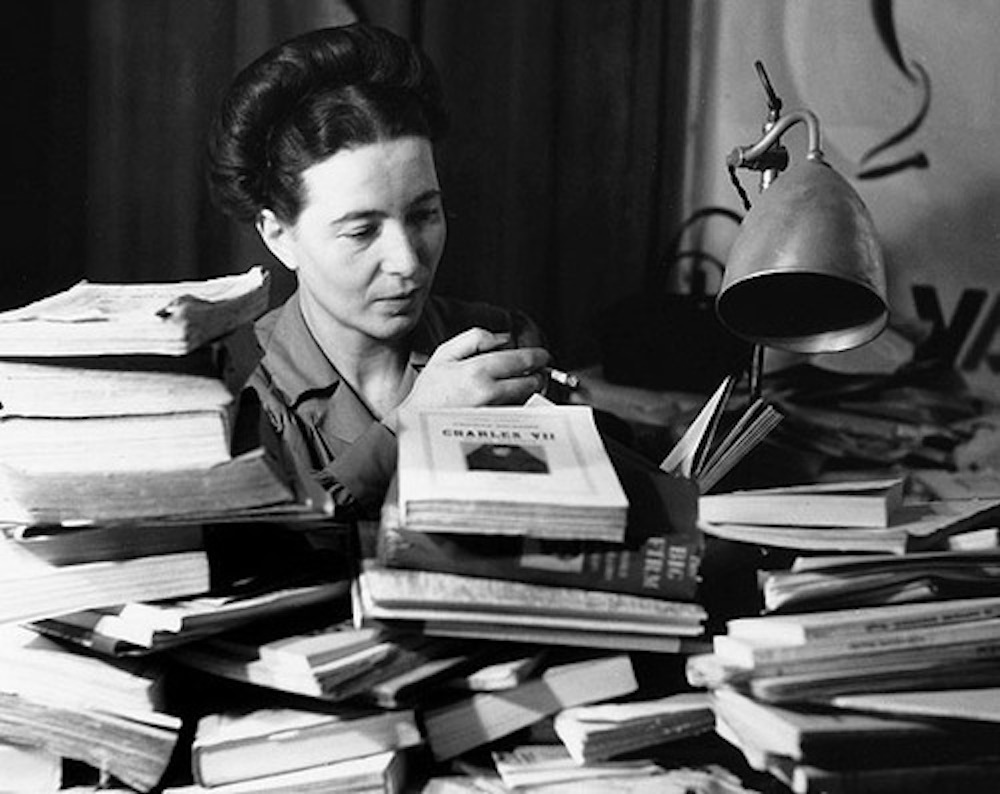
Children vs. Body vs. Career vs. Praying Mantis?
De Beauvoir specifies different limitations imposed upon women, especially motherhood. Women cannot reconcile reproductive and productive capacities in patriarchal society: mothers are primary caregivers, not bankers, artists, chefs, or any other profession for that matter. Women become the default parent because of their reproductive organs and idealized compassion—both things beyond their control. De Beauvoir takes issue with these premises, claiming that the female body limits subjectivity and “circumscribe[s] her within the limits of her own nature.”
“The body is not a thing, it is a situation: it is our grasp on the world and our sketch of our project.”
While de Beauvoir offers a pretty badass diatribe against social stigmas surrounding motherhood and pregnancy, she ultimately lures women from the domestic sphere. According to de Beauvoir, reproductive capabilities unjustly label women as the second sex and relegate them to the home. More than just a body, women deserve to experience much more! Like men, each woman is subjective and holds a destiny and desires.
Almost seventy years later, de Beauvoir’s voice resounded at the Women’s March. Her legacy was apparent through all participants—women, girls, men, and boys. Men and boys? Remember, our girl is smart: she calls for reciprocity and aims for gender equality, not difference. Paving the way for contemporary feminism, she inspires individuals and groups to acknowledge their opposites as more than just Others. However, de Beauvoir also presents uniquely feminine historical and philosophical advancements. Her magnum opus, The Second Sex confronts human history from a female perspective. “I am a woman,” she proclaims—and, unlike before, it seems sufficient. Coming from a female defining herself in feminine terms, this simple statement becomes radical. The fact that this statement seems less radical today proves that women are no longer the second sex, and we can thank Simone for that.
Below are the most profound takeaways from the iconic book:
“No one is more arrogant toward women, more aggressive or scornful, than the man who is anxious about his virility.”
“Representation of the world, like the world itself, is the work of men; they describe it from their own point of view, which they confuse with absolute truth.”
“…her wings are cut and then she is blamed for not knowing how to fly.”
“If the feminine issue is so absurd, is because the male’s arrogance made it “a discussion”
“What would Prince Charming have for occupation if he had not to awaken the Sleeping beauty?”
“Women’s mutual understanding comes from the fact that they identify themselves with each other; but for the same reason each is against the others.”
“If I want to define myself, I first have to say, “I am a woman”; all other assertions will arise from this basic truth. A man never begins by positing himself as an individual of a certain sex: that he is a man is obvious.”
“Masculine desire is as much an offence as it is a compliment; in so far as she feels herself responsible for her charm, or feels she is exerting it of her own accord, she is much pleased with her conquests, but to the extent that her face, her figure, her flesh are facts she must bear with, she wants to hide them from this independent stranger who lusts after them.”
“A woman alone always seems a little unusual; it is not true that men respect women: they respect each other through their women—wives, mistresses, “kept” women; when masculine protection no longer extends over her, woman is disarmed before a superior caste that is aggressive, sneering, or hostile.”
“Doomed to procreation and secondary tasks, stripped of her practical importance and her mystical prestige, woman becomes no more than a servant.”
“If so few female geniuses are found in history, it is because society denies them any means of expression.”
“[Woman] is simply what man decrees; thus she is called “the sex,” by which is meant that she appears essentially to the male as a sexual being. For him she is sex — absolute sex, no less. She is defined and differentiated with reference to man and not he with reference to her; she is incidental, the inessential as opposed to the essential. He is the Subject, he is the Absolute — she is the Other.”
